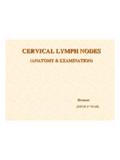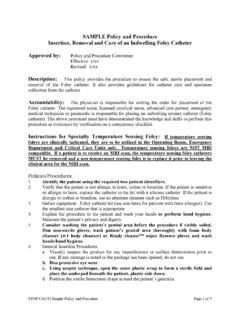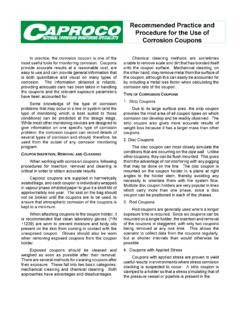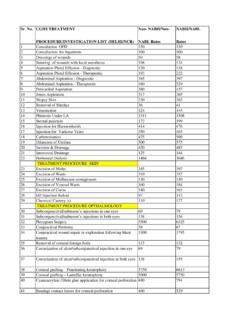Transcription of Chest Tubes: From Indications to Removal
1 Chest tubes : From Indication to RemovalObjectives Review respiratory anatomy and physiology. Discuss assessment of the pulmonary system. Recognize Indications for Chest tube placement. Explain nursing responsibilities with Chest tube insertion , daily care, trouble shooting, and of the Respiratory TractUpper Respiratory Tract:NoseMouthNasopharynxOropharynxLary ngopharynxLarynxLower Respiratory Tract:TracheaPrimary Bronchi Lobar BronchiSegmental BronchiMusculoskeletal Anatomy of RespirationThoracic Cage:ManubriumRibsSternumVertebral ColumnXiphoid ProcessMuscles of Respiration:DiaphragmExternal IntercostalsAccessory Muscles.
2 Abdominal RectusInternal IntercostalsPectorals Posterior Trapezius SternocleidomastoidInspiration Active process Thoracic cage expands Diaphragm contracts and lengthens thus lifting ribs upward and outward and displaces abdominal contents downward External intercostal muscles contract and pulls ribcage upward and increases width Net effect of is twofold: Intrathoracic volume increases and pressures are lowered Pressure gradient causes air to move into lungsExpiration Relatively passive process Diaphragm moves upward and external intercostals relax, size of thoracic cage decreases Accessory muscles contract, ribcage moves upward.
3 Abdominal contents rise Pressures become slightly positive and air flows out of the lungsA Little Physiology Human breathes 12-15/minute About 500 milliliters per breath 6-8 liters/ minute Air mixes in alveoli Oxygen enters blood in pulmonary capillaries Carbon dioxide enters the alveoli 250 milliliters of oxygen enters while 200 milliliters of carbon dioxide departs 250 volatile substances identified in human breathAssessment of Respiratory System Presenting illness Past medical history Physical assessment:InspectionPalpationPercussion Auscultation of breath sounds and quality of voiceInspectionRelaxed, effortless, occasional sighing, eupnea, pink, moist mucous membranes, trachea midline and straight, symmetrical Chest , scapulae on same horizontal plane, alert and oriented, inspiration to expiration ratio 1.
4 2, angulation at base of nail and finger, diaphragmatic (male) vs thoracic (female) breathing, spine straight, sitting or reclined without difficultyPalpation Presence and quality of pulses Skin smooth, warm, and dry Capillary refill less than 2 seconds Mild vibration on Chest wall during vocalization Spine and ribs non-tender symmetrical lateral Chest expansion (3-8 cm) Percussion Resonance is easily heard. Equal quality bilaterally. Low-pitched and hollow sounding . Diaphragmatic excursion 3-5 cm and hemi-diaphragm moves 3-6 : Heard around trachea and larynx Harsh, hollow, tubular quality Loud, high-pitchedBronchovesicular: Heard around scapulae, upper sternum in first and second intercostal spacesVesicular: Heard over peripheral lung fields Low, soft rustling soundsAdventitious Lung Sounds Crackles: Fine, high-pitched/coarse low-pitched, short, discontinuous, commonly heard during inspiration, indicative of air passing though fluid in small airways Rhonchi.
5 Low-pitched, continuous snoring sound, commonly heard during expiration, potentially large airway obstructed by fluid Wheezes: High-pitched whistling sounds, heard in expiration and inspiration, indicates air passing through narrow airways Pleural Friction Rub: Scratching, grating, rubbing, creaking best heard at base of lung during end-expiration, and indicates inflamed pleura.\The Patient in Respiratory Distress Abdominal/Accessory muscles use. Abnormal breath sounds Asymmetrical Chest wall motion Decreased oxygen saturation Decreased urine output ECG changes Hyper/hypoventilation Jugular venous distention Nasal flaring Restlessness/confusion/agitation Shortness of breath Skin color changes Tachycardia and hypertension Tracheal shiftNormal Chest Roentgenogram (X-ray)Based on systematic evaluation.
6 Soft tissues of neck, shoulders, breasts, axillae, diaphragms, and upper abdomen Skeletal structures such as clavicles, ribs, vertebrae, scapulae, and sternum Trachea, bronchi, pleural spaces, and lung parenchyma tubes , lines, and monitoring devicesComparison of Chest Radiographs (Pneumothorax)Normal Chest X-raySimple PneumothoraxCollapsed lungComparison of Chest Radiographs (Pneumothorax)Normal Chest X-raySimple PneumothoraxDeep Sulcus SignComparison of Chest Radiographs (Pneumothorax)Normal Chest X-rayTension PneumothoraxNote the mediastinal shift !
7 !Comparison of Chest Radiographs (Hemothorax)Normal Chest X-ray Right HemothoraxPatient Supine blood layers inferiorlyComparison of Chest Radiographs (Hemothorax)Normal Chest X-ray Right HemothoraxPatient Prone blood layers of Chest Radiographs (Pleural Effusion)A pleural effusion and a hemothorax look the same, depending on the position of the of Chest Radiographs (Hemopneumothorax)Comparison of Chest Radiographs What do you see?Normal Chest X-ray Well?
8 Comparison of Chest Radiographs (?????)NGT floating freely in the left for a ruptured left hemidiaphragm !!A Little History Hippocrates (470-500 BC) described techniques to cannulate the pleural space Hillier (1867) opened empyema under water Playfair (1872) introduced water seal Hewett (1876) incorporated use of continuous Chest drainage system with water seal WWI Army formed Empyema Commission WWII saw use in thoracotomies Korean War saw use in traumaIndication for Chest Tube Placement Pneumothorax Hemothorax Symptomatic pleural effusion Empyema Complicated parapneumonic effusion Chylothorax Sclerosis of recurrent malignant effusionsChest tubes French sizing refers to the diameter of the tube in millimeters from 8-40 Fr Tube is sterile, flexible.
9 Nonthrombogenic composed of vinyl or silicone Typically packaged with aluminum trocar Measures 20 inches in length (50 cm) Proximal end is fenestrated Indications and patient size dictates size Pneumothorax: 20-24 Fr Fluid: 28 Fr Average adult/teen male: 28-32 Fr Average adult/teen female: 28 FrChest Tube InsertionInsertion site is at the 6th intercostal space, anterior axillary lineConsent is obtained and the procedure is explainedPretreatment with analgesia, oxygen, and/or anxiolyticsPatient placed supine and arm raised over head.
10 Chest Tube InsertionChest is surgically prepared in normal sterile fashionLocal anesthetic is infiltrated into skin, subcutaneous tissue, Chest wall, intercostal muscle, periosteum, and parietal pleuraChest Tube Insertion1-inch incision is made directly over the ribChest Tube InsertionA hemostat is used to spread the subcutaneous tissues down to the rib. It is then used to pop into the pleural space just above the ribChest Tube InsertionAfter the pleural space has been penetrated, a hemostat is used to grasp the tip of the Chest tube and guide it through the subcutaneous tunnel and into the Chest cavityChest Tube InsertionThe incision is closed and the Chest tube is tied in placeCommon Complications of Chest Tube insertion Allergic reaction Bronchopleural fistula Cardiac injury Hemorrhage Hepatic injury Infection Intercostal nerve, artery.









